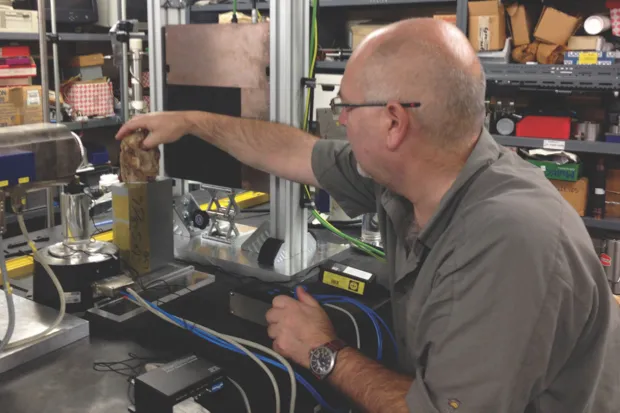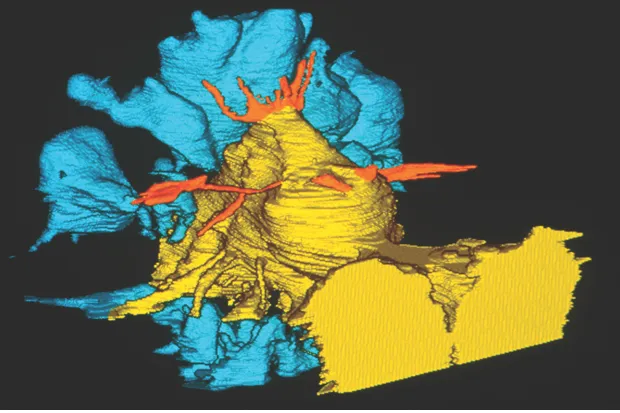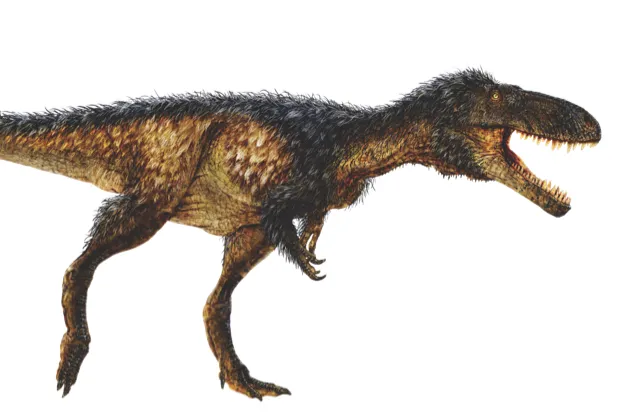A few years ago, as I loitered in the lobby of a high-rise hotel in Berlin, a man tapped me on the shoulder. In his thick Russian accent, he ushered me into the lift and up to his room. From a duffel bag, he pulled out an ornately coloured cardboard box and handed it to me. I slowly opened the lid. Inside was a grapefruit-sized lump of petrified bone, whichI recognised as the back end of a dinosaur skull.
“Be careful with the fossil, but be even more careful with the box. This is Soviet box. They don’t make them like this anymore,” he said with a mischievous grin, as he pulled out a bottle of cognac to toast the successful handover.
The man was no secret agent. He was Alexander Averianov, one of Russia’s leading palaeontologists and a fellow dinosaur hunter. Nearly a decade before he led an expedition to Uzbekistan’s Kyzylkum Desert, a barren expanse that yields some of the world’s best Cretaceous-aged fossils. While there, someone on his crew plucked the skull from the sand dunes and safely packed it in the box, where it sat for several years as Averianov tried to make sense of it. He could tell it was the fused mass of bones that surrounded the brain and ear, but wasn’t sure what type of dinosaur it belonged to, much less how it might have behaved and interacted with its environment. To figure that out, he would somehow need to see inside the skull: to look at the brain.
This is why he gave the boxed fossil to me, soI could take it to my lab at the University of Edinburgh and analyse it with a computed tomography (CT) scanner. CT scanning – the same technique employed by medical doctors – has become as indispensable to palaeontologists as rock hammers and chisels. By scanning dinosaur skulls, we can literally see inside them and visualise the brains and other rarely fossilised internal structures that powered the intelligence and sensory prowess of these long-dead animals. This helps us understand dinosaurs as living, thinking, moving, evolving creatures, in a way that previous generations never could.
Skull scanning
Back in 1912, after the first skeletons of Tyrannosaurus rex were discovered, scientists were desperate to understand how such a humongous animal actually lived. The man who named T. rex, Henry Fairfield Osborn, knew that the brain held the key. Brain tissue decays quickly after an animal dies, so Osborn conceded that a real dinosaur brain could never survive for millions of years. But perhaps if he could peer into the brain cavity – the space the brain once occupied inside the skull – he could get a sense of the size, shape and dimensions of the brain.
This, however, raised another problem. He could think of only one way to access the brain cavity, so he sawed open a skull of T. rex, permanently damaging it – a sacrifice in the name of science.
Not many other scientists had the nerve to cut up their fossils, so for the next several decades there was little research on dinosaur brains. Every once in a while, palaeontologists would find so-called ‘natural endocasts’: mud or sand that had filled the brain cavity, hardened to stone and then broken free. These were enough for Dr Harry Jerison and Dr James Hopson – two pioneers in the field – to argue that dinosaurs had fairly typical reptilian brains. But they couldn’t say much more than that.

Then, beginning in the 1990s, CT scanning changed the game. CT scans are nothing more than X-rays, taken from many angles. If you stick an object in a CT scanner – whether it be a human body or a dinosaur fossil – the X-rays will pass through the object in an orderly manner, and then a computer will combine them into a series of two-dimensional slices. Each slice looks like a traditional X-ray image, of the sort you get at hospital when you break a bone or sprain a ligament.
Like the X-ray images we’re familiar with, the CT scan slices pick up density differences between materials, so bone shows up asa different greyscale colour to air or sand or mud. The series of CT slices is essentially a flipbook of images, which specialised software can assemble into a digital 3D model of the entire object that was scanned. Thus, the scan allows palaeontologists to see inside a fossil without cutting it open, the same way it permits a doctor to visualise the details of our internal anatomy without needing to do surgery.
CT scanning revolutionised palaeontology just as it did medicine. Now, scientists can simply put dinosaur skulls in a scanner and generate digital models of the filled-in brain cavity, inner ear, blood vessels, nerves and sinuses. It’s non-invasive, relatively inexpensive and can be done using the same equipment found in almost any hospital. Nowadays, palaeontologists have become so accustomed to CT scanning that many of us have bespoke scanners in our labs or even use synchrotron particle accelerators to generate the high energies needed to scan sub-micron-sized details of the tiniest fossils.
All brawn, no brain?
The oldest dinosaurs, which lived during the Triassic Period (around 230 million years ago), had small and fairly primitive brains that were not too different from those of other reptiles. Some plant-eating dinosaurs retained these rudimentary brains, including the famous plate-backed Stegosaurus, which lived during the Jurassic Period (around 150 million years ago).
Stegosaurus was a popular punchline in the dinosaur books that I read as a kid, with its supposedly ‘walnut-sized’ brain exemplifying how dinosaurs were lethargic dullards that were poorly suited to their environments. As with so many cherished stories about dinosaurs, this turns out to be mostly wrong. Dr Ashley Morhardt, a palaeontologist at Washington University in St Louis, Missouri, scanned a Stegosaurus skull and found that the brain is indeed small for a dinosaur, but it was closer in size to two or three walnuts. No doubt, this was more than enough brainpower for Stegosaurus to survive in the rough-and-tumble world of the Jurassic. Even the dullest dinosaurs were much smarter than popular culture gives them credit for.
Another group of herbivores modified the brain and inner ear to fit their lifestyles. Sauropods – the group of pot-bellied, long-necked behemoths that included Diplodocus and Brontosaurus – were the biggest animals to ever live on land. The earliest sauropods were dog-sized critters such as the Triassic’s Saturnalia, which had a small brain with big flocculus lobes that permitted fine-tuned head,neck and eye movements.
As sauropods got bigger and started walking on four legs, the flocculus got smaller, as did the semicircular canals of the ear, which help regulate balance. It seems as if sophisticated locomotion was becoming less important to these animals as they devoted more time and energy to eating the huge quantities of leaves and stems needed to power their ever-growing metabolism.
There’s something else peculiar about the hugest sauropods: different species had inner ears oriented in different directions. It’s widely known that in living animals the lateral semicircular canal of the ear is held in a horizontal plane when theanimal employs a ‘neutral’ head posture.
A study by University of Chicago palaeontologist Dr Paul Sereno found that some sauropods, such as the spatula-toothed Camarasaurus stuck their heads out nearly straight when in this neutral posture, but others like Nigersaurus pointed their heads downwards. This suggests that Camarasaurus-type sauropods lifted their necks high into the air, whereas Nigersaurus was more like a vacuum cleaner that sucked up plants near the ground.
Sauropods were evidently changing their sensory systems to allow them to feed in different styles and on different types of plants, which is probably one reason why so many species were able to coexist in the same environments, as they weren’t competing with each other. Sensory changes, therefore, were one of their keys to success.
Who’re you calling featherbrained?
Meat-eating theropods, such as T. rex and Velociraptor, are celebrated for their sharp teeth and killer claws, but their arsenal of predatory weapons also included keen intelligence and senses. The smartest dinosaurs of all were small, feathered species closely related to birds, such as Velociraptor, Troodon and Zanabazar.
Dr Amy Balanoff of Johns Hopkins University has built her career studying the brains of dinosaurs, meticulously scanning fossil after fossil, including many stellar Cretaceous-aged skulls (around 75-80 million years old) that Dr Mark Norell, a palaeontologist from the American Museum of Natural History, excavated from the Gobi Desert.

These feisty, fast-running predators had, proportionally, the largest brains, relative to body size, of any dinosaurs. This is largely due to their enlarged cerebrums and it means that they were probably among the most intelligent of all dinosaurs. Not only that, but their brains are essentially indistinguishable in size and shape from the brains of the oldest birds, which may indicate that some of these Velociraptor-grade theropods were capable of flight.
Work by University of Calgary palaeontologist Dr Darla Zelenitsky has also shown that the ‘raptor’ dinosaurs had proportionally huge olfactory bulbs relative to most other theropods, suggesting they used a sharp sense of smell to seek out their prey. Whether they were capable of the kind of cunning depicted in Jurassic Park is a matter of speculation, however!
As fearsome as a pack of Velociraptors would have been, no theropod eclipses the King of Dinosaurs: T. rex. Over a century ago, Osborn’s sawed-up skull hinted that T. rex had a fairly large brain and more recent CT work by Dr Larry Witmer of Ohio University confirms it.

In fact, not only was T. rex roughly as intelligent as a chimp, but it had enormous olfactory bulbs that imparted a strong sense of smell, elongate and looping inner ear canals that coordinated rapid eye movements and quick reflexes, and an elongate cochlea that could hear low-frequency sounds. If a 13-metre-long, 7-tonne, bone-crunching predator wasn’t scary enough, its brainpower and sensory acumen ensured that T. rex was the biggest, baddest predator that ever lived.
This raises a question: how did T. rex evolve these features? The boxed-up skull that Averianov gave me in Berlin provides the answer. When I brought the skull to Edinburgh, I handed it over to Dr Ian Butler, my geochemist colleague who hand-built his own CT scanner, and my student Amy Muir, a maestro at reading CT scans. Our visualisation of the brain showed that the skull – which we later named as a new species, Timurlengia euotica – had the characteristic elongate and peaked brain ofT. rex, with a long cochlea.
But T. euotica was much smaller, only about the size of a horse, and lived about 25 million years before T. rex. Thus, the ancestors of T. rex evolved big brains and keen senses before they developed huge body size. So tyrannosaurs got smart before they got big – and getting smart was probably what allowed them to rise to the top of the food chain, grow to monstrous sizes and become the ultimate dinosaur success story.
This is an extract from issue 323 of BBC Focus magazine.
Subscribe and get the full article delivered to your door, or download the BBC Focus app to read it on your smartphone or tablet. Find out more
[This article was first published in June 2018]
Follow Science Focus onTwitter,Facebook, Instagramand Flipboard
